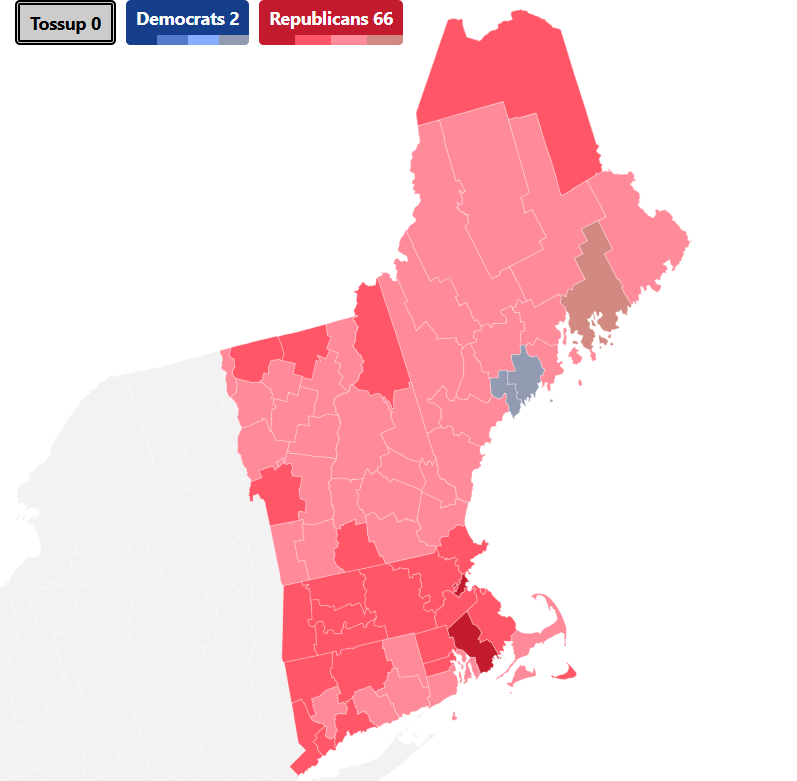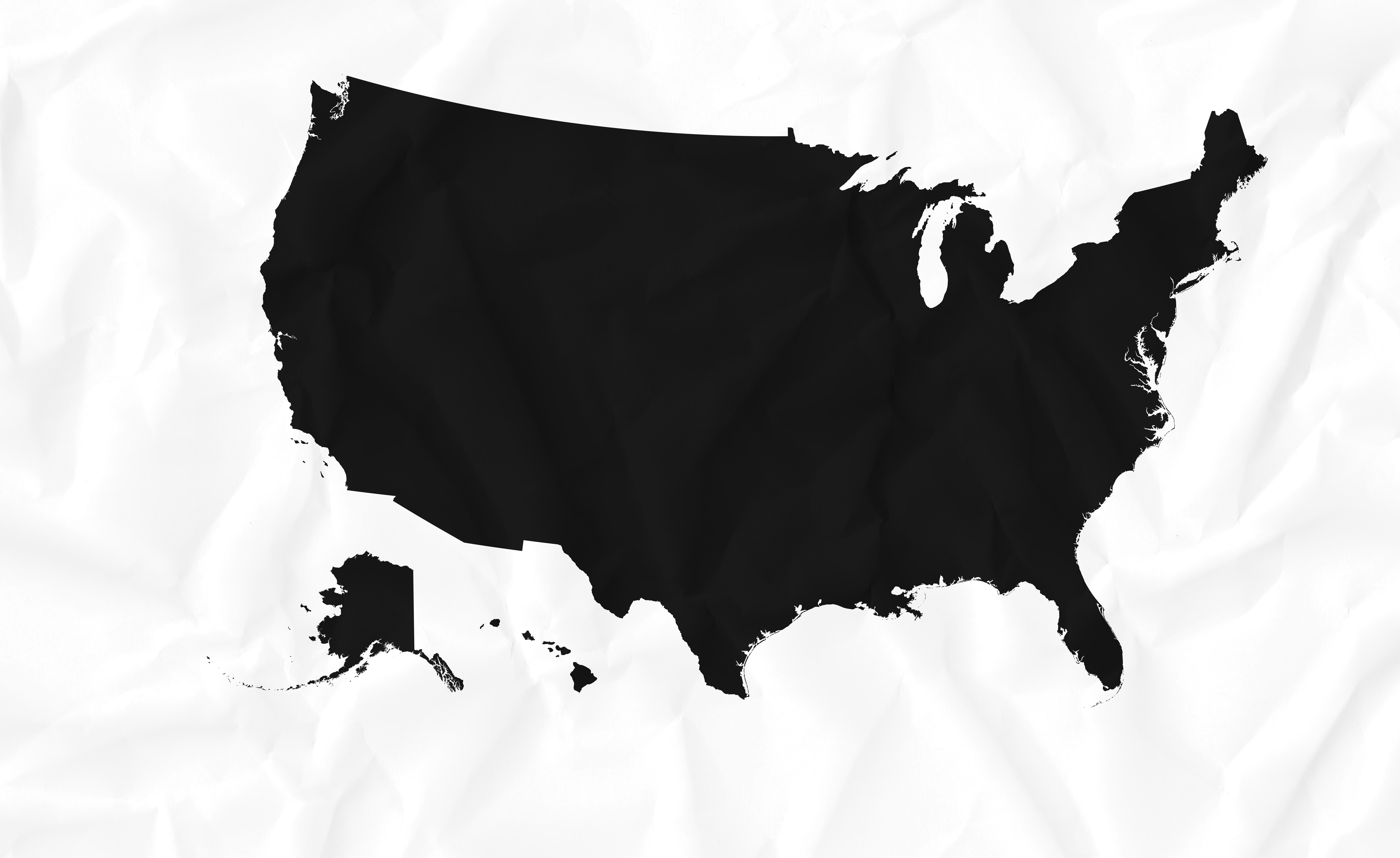The 2024 presidential election is still being examined, but the results are rather surprising in modern standards, and although the election was not a landslide, getting under the hood shows it was a solid, and possibly realigning, election. For the next several weeks, we’ll discuss in-depth the results from each state, specifically on the county level, as to where and why the shifts were so pronounced.
This also gives us an opportunity to add a new ledger in our “America the Beautiful” history column that ran weekly on this page before we began Civics 101. Under the “Current Political Leanings” section, we would discuss the recent electoral profiles of each state. This sub-column will effectively allow us to check back in where we left off.

The General Region
New England is composed of six states: Connecticut (7 electoral votes), Maine (4 split), Massachusetts (11), New Hampshire (4), Rhode Island (4), and Vermont (4). The six have voted for the same party together in every election since 2004, with New Hampshire in 2000 being the last time a New England state backed a GOP nominee. The only exception to this is Maine, which splits its electoral votes based on congressional district winners. The winner of the popular statewide vote receives two electoral votes, while the individual popular vote-winners in the two districts each receive an additional electoral vote. Maine adopted this system in 1972, but no candidate had ever created a split until 2016. Donald Trump (R-NY) won ME-02, netting him one electoral vote.
The region was once one of the most Republican in the country, with its heavy Yankee roots started long before the Revolutionary War as the classic “live free or die” states. The regions’ political leanings have been demonstrated throughout history. In 1856, the first election after the birth of the Republican Party, each New England state went to that year’s nominee, John C. Fremont (R-CA), with only New Hampshire being relatively close.
In fact, no New England state would back a Democratic candidate from 1856 until 1876, when Samuel Tilden (D-NJ) took Connecticut very narrowly that year. New England as a whole – except Connecticut in some elections – would back the GOP in every election again for the rest of the century, and handily until the 1920s. Immigration to the region, namely Irish Catholic and Italian immigration, would start to push the area towards Democrats, but socially speaking, the region was still in line with the GOP.
The region was fully solidified with the “blue wall” in 1992, a watershed election that realigned political groups across the country. New England was always a classically Republican area for its ideas on limited government, high education, and more classically liberal ideals. Once the national GOP took social positions that were deemed more conservative, the “classically liberal” areas of the country, most predominantly seen in New England, shifted towards a more “presently” liberal platform, backing the Democratic Party in every election since 1992. Only New Hampshire has broken that streak.
The only New England states that have been decided by margins of less than ten points since 2000 are New Hampshire and Maine, with Vermont being an exception in 2000. The Obama years took most of New England out of play, but 2016 put them back in.
While not at the forefront of the presidential battleground this year, the entire region shifted to the right, in some ways, dramatically so.
Massachusetts
We’ll start in Massachusetts, long a liberal stronghold, and one of the most guaranteed Democratic prizes on perhaps any election night. It’s also the population center of New England, clocking in with eleven electoral votes. Having not backed a Republican since 1984, Massachusetts shows no signs of becoming competitive, but the rightward shift this year cannot be ignored.
In 2020, Joe Biden (D-DE) carried the Bay State with 65% of the vote to Trump’s 32%, with the former sweeping all counties, a feat every Democrat has performed since 1992. Kamala Harris (D-CA) won the state with 61% to Trump’s 36.5%, an eight-point swing compared to four years ago. Every single county swung somewhat significantly towards Trump, but the largest county swing there was Suffolk County, home to Boston. Harris lost about 70,000 votes to Biden’s 2020 total, allowing the region’s population center and one of the most liberal strongholds in the country to shift more rightward than the rural counties, which still lean significantly Democratic.
This is the first election since 1924 in which a Republican carried the City of Fall River, the first since 1956 that a Republican won Somerset, and the first since 1984 that a Republican won Westport, Seekonk, and West Springfield. Of the commonwealth’s 351 municipalities, Trump flipped twenty-six; Harris flipped none.
Interestingly, in the concurrently held Senate race here, John Deaton (R) actually overperformed the top of the ticket, taking in just over 40% of the vote to two-term Senator Elizabeth Warren’s (D-MA) 59.6%. He also won Bristol and Plymouth counties in the southeastern part of the state. The underperformance by Warren, although not drastic, has hurt Democrats’ popular vote standings in the Senate races – which stands at about one percentage point – a very close popular vote count when Democrats defended almost double the number of states Republicans did in this cycle.
New Hampshire
A classic swing state, and the only to hail from New England, New Hampshire was closer than expected this year, although it was largely absent from the campaign trail. Trump swung all nine of the Granite State’s counties to the right this year, with the biggest swings observed in Coos and Cheshire counties. Harris won the state with a thin majority – 50.65% – to Trump’s 48%. He flipped three counties he had lost four years ago, but the culprit for his loss in New Hampshire could be considered Grafton County, home to Dartmouth. New Hampshire’s large college-educated population was initially seen as one of the biggest hurdles for Trump to clear, as evidenced early this year by Nikki Haley’s (R-SC) strong performance in this region in the primary.
For comparison, Biden won the state by almost eight points – 52.7% to 45.3%. The 2020 election saw New Hampshire move off the map towards the end, and Trump ultimately only carried two counties. It makes for a scenario where Harris underperformed Biden, but outperformed Hillary Clinton (D-NY).
In terms of raw votes, with almost 75% turnout, New Hampshire is shaping up to be the closest state in terms of raw votes. Trump and Harris are separated by No Republican has won New Hampshire since George W. Bush (R-TX) in 2000.
The concurrent governor’s race saw former Senator Kelly Ayotte (R) win the open seat handily, continuing the GOP gubernatorial winning streak here since 2016.
Vermont
Although Vermont is one of the most liberal states in the country, Democrats might have hit a ceiling here. Like Massachusetts, it’s not a state that appears ready to become competitive again, but Trump swung every county in his favor and even flipped another – Orleans County, becoming the first Republican to do so since 2004.
Governor Phil Scott (R-VT) also won a resounding landslide victory for a fifth two-year term. The liberal Republican is regularly recorded as the most popular governor in the country, and his coattails this year are credited with state Republicans’ piercing of Democratic supermajorities in both chambers of the state legislature.
Biden wook 66% of the vote in Vermont four years ago, compared to Trump’s 30.5%. Harris took 63% of the vote to Trump’s 32%, accounting for about a five-point swing to the right. Trump also held Essex County, once a notable bellwether county, and came very close to flipping Franklin County, which has not backed a Republican since 1984.
While not a surprise, this is only the second time in history, since 1956, that Vermont was the strongest state for either party in two back-to-back elections. Moreover, it speaks to Vermont’s traditional Republican lean and that its sharp transition to the bluest state is mostly unparalleled by any other state.
Maine
Maine was once a competitive state at the beginning of the decade, but Obama pushed it thoroughly off the map in 2008. Trump held Clinton to a thin margin here in 2016, suggesting Maine could become a battleground. Only modestly competitive in 2020, Biden outdid Clinton’s 2016 numbers, only for Harris’ margin to rest between the two. Like New Hampshire, Maine is another state where Harris outperformed Clinton but underperformed Biden.
Maine is also the site of the only two New England counties that voted more Democratic this year than last year: Sagadahoc and Lincoln, the latter of which has not backed a Republican since 2000, and the former of which has not done so since 1988. As coastal counties, they make up the liberal portion of Maine and its First Congressional District.
The margin for Harris stands at 52.11% to Trump’s 45.36%, compared to a 53.09% win for Biden to Trump 44.02% in 2020.
It appears that Maine is still in contention, and if enthusiasm for a Republican nominee meets or exceeds 2016-levels in this state, then it’s likely Republicans could pick off another New England state, as Maine has not voted for a Republican presidential candidate since 1988.
Connecticut
A state that we had suggested would be “Likely Democratic” as opposed to “Safe Democratic” in our 10/31 forecast, Connecticut shifted about five points to the right this year. Trump held the two mainstay Republican counties here – Litchfield (Danbury) and Windham – and received about 42% of the vote to Harris’ 56%, down from the 59%-39% gap we saw favoring Biden four years ago.
Connecticut also recently reorganized its local levels of government into “Council of Governments” regions, or “Planning” regions. Of the nine, Trump won three, flipping the Northwest Planning Region red.
Having not backed a Republican since 1988, Connecticut’s shift this year was less pronounced than its counterparts, particularly New Jersey and New York, which we’ll discuss in a later column. It’s possible Republicans find some more room to grow here, but their floor of about 40% wasn’t changed much by this year’s results. It is notable, however, that some networks, including CNN, did not call Connecticut until early Wednesday morning, a huge departure from the typically-safe Democratic results projected for the Constitution State.
Despite this, Trump flipped fourteen municipalities, including Bristol, the state’s twelfth-most populous city. Harris flipped the small town of Warren.
Rhode Island
We’ll end this mini-series with the nation’s smallest state, Rhode Island. A reliably Democratic state, Rhode Island gave Joe Biden 59% of the vote to Trump’s 38.6%. However, the state swung about eight points to the right, one of the largest shifts observed this election. Although Trump did not flip back Kent County, which he had flipped in 2016, Harris’ margin was thinner here than it was in arguably “redder” Connecticut – 55.5%-42%.
The result marks the closest election in the Ocean State since 1988, as well as the first election since 1936 in which Rhode Island voted to the right of Connecticut, and the first since 1956 that it voted more Republican than Delaware, Oregon, or Washington.




